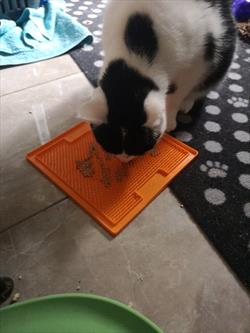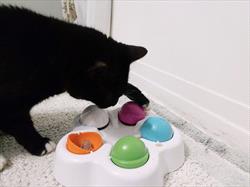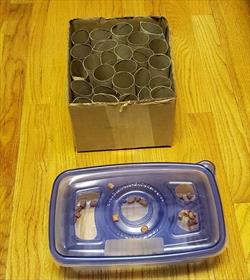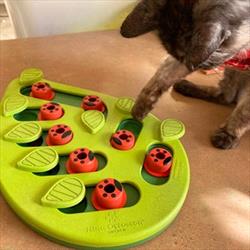Cats retain many behaviors of their wild ancestors. As predators, they have strength, agility, speed, and keen senses to catch prey effectively. Owners can help their feline friends express these natural skills during mealtimes. Food enrichment provides physical and behavioral well-being for the cat and enjoyment for the family.
Use the following tools to feed part of the daily meal or special treats. Many diets, including prescription diets, can be enhanced with wet or dry foods.
Cat Licking Food Off Silicone Tray

Photo Courtesy of Kitty Fleming
Wet food can be smeared since cats lick up their meals
- Put food on a paper plate, and it slides around a smooth floor. The cat keeps moving to “catch” the food.
- Spread food onto a silicone potholder to provide nooks and crannies for extra licking. Place the potholder on the floor or hang it on a wall.
- Commercial feeders can be purchased online or at pet stores that enable canned food feeding.
Commerical Cat Feeder

Photo Courtesy of Paisley Lunchick
Dry food can be placed in puzzles that cats bat, push, and move about to get the food to fall out
- Fold toilet paper tubes stuffed with kibble for pushing, swatting, and chewing.
- Stand paper tubes upright and pack them tightly inside a box for paw scooping.
- Cut paw-sized holes and strips atop a shallow box or a clear container for batting and scooping.
- Many commercial puzzles available for small dogs work well for cats. Put lots of kibble in the puzzle to help novice cats be successful.
Homemade Puzzles

Photo courtesy of Sherrie Yuschak
Hide and seek because cats use the sense of smell to find food
- Filled puzzle feeders can be hidden within a room or house to encourage the cat to find them.
- Use a wand cat toy to play, then direct the cat to the hidden food.
- Scatter kibble on cat trees, shelves, behind plants, and couches. Start with easy hides in a small room and increase the search difficulty as the cat improves.
Food Puzzle

Photo Courtesy of Bec Hamilton
Interactive games build a better bond
- Wand toys can be used to play and direct the cat during the hide and seek game.
- Clicker training is a great way to feed meals and teach healthcare behaviors.
- Let your cat watch you fill the puzzle and sit with them while they work.
- Quickly slide a piece of kibble across a smooth floor for running and pouncing fun.
Safety Tips
Supervise pet interactions when using these in a multi-pet household.
Observe your cat during food enrichment to be sure they don’t get stuck, injured, or become frustrated.
Small meals in feeders prevent gulping and may lessen vomiting.